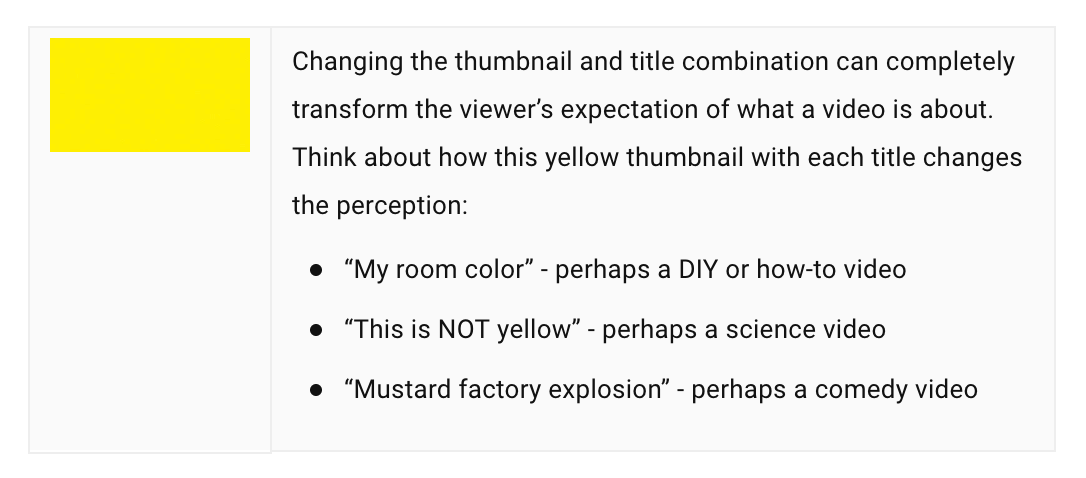Continue with the way to build a profitable Youtube keyword strategy…
Optimizing your content for search
When you’ve chosen a keyword to target for your video, it’s time to optimize your content material so YouTube knows that your video is a good match.
We’ll come back to that point a few times, however, it’s valued calling out: When it comes to optimization, your real purpose is to help YouTube know what your content material is about. It’s not too difficult, and the most important factor is that you’re consistent and clear so your viewers can discover what they’re searching for.
Title
There are two things your video title does when it comes to SEO to build a profitable Youtube keyword strategy.
- Impacts click-through rate. When somebody searches for your keyword, they’re not just going to search out your video—they’re going to get a listing of similar outcomes. You want your title to be clear, descriptive, and most of all, engaging to win their attention and their click on. If more people are clicking on your title than on others, it’s going to be a signal to YouTube that your video is an effective match for this keyword.
- Signals keywords. You need to embody your primary keyword in your title because your title is one of the most important pieces of metadata that YouTube has to figure out how related your video is to a particular keyword.
The one thing you want to keep away from, nevertheless, is clickbait. Ensure you’re not overpromising in your title, or utilizing elements like all-caps or excessive punctuation. YouTube is very clear that clickbait—even if it doesn’t violate their group guidelines directly—won’t perform as well in search.
Thumbnails
YouTube’s search outcomes offer you even more control over what a potential viewer sees as a result of you have a thumbnail displayed next to your search outcome. It’s an excellent opportunity to offer extra information about the video and what viewers can expect, so optimizing your thumbnails can help you improve both your click-through rate and your watch time.
Fortunately, you may add custom photos as your video’s thumbnail, so you’re not limited to just a still frame from the video. According to YouTube, 90 percent of top-performing videos on this platform has a custom thumbnail.
Your thumbnail works with your title to affect your click-through rate, so if you’re designing a thumbnail, it’s necessary to consider them together, as in this instance YouTube gives.
While you want your thumbnail to be intriguing, you also want it to be an accurate representation of the video. If it’s misleading, you may get plenty of clicks, however, see people leaving nearly immediately. YouTube is clear that this type of behavior will limit your video’s performance in search outcomes.
Similar to your title, your thumbnail is another necessary piece of metadata for your video according to YouTube. To take advantage of it, save your picture file with your keyword included in the file title. It’s one additional method to signal that your video is relevant to that keyword.
Lastly, it doesn’t matter what design choices you make for your thumbnails, ensure they stick with YouTube’s recommended picture ratio and sizing: 1280px x 796px for your thumbnail photos, with a minimum width of 640px.
Description
Your video’s description provides you an opportunity to use your primary keyword again and embody almost as much relevant content material as you’d like. You’ve got 5,000 characters to work within your description so you’ve received the space to make an impact—however, there are some tips to remember.
Use your main keyword early on.
Similar to in your title, you’ll want to prioritize utilizing your keyword at the beginning of your description, though it doesn’t have to be the first word in the sentence according to YouTube. It is a good signal to YouTube that yes, your video is actually about that keyword, however, it could also help customers decide they’ve discovered what they’re searching for and that they should watch your video.
Pay attention to your first sentence or two.
Though YouTube provides you 5,000 characters, seeing that entire text on each video would be overwhelming. If you land on a video, only the first 100 characters or so tend to be shown above the “Show more” link, according to estimates by HubSpot—though how many exactly varies based on where your video is displayed.
This instance, from Luxy Hair, provides you with a quick glimpse of the video’s description, and you may increase it to see more when you’d like to.
That means that the first few sentences, particularly the first sentence, of your video’s description are a valuable piece of content material real estate. You need to make them compelling, and ensure to include your keyword.
Write in a natural language.
While it could be tempting to stuff your description full of keywords, an easy-to-read description that accurately describes the video is the best way to help customers and bump your videos up in the rankings. YouTube particularly recommends not listing out all your keywords in your description, since that’s what your tags are for.
Make a default description to control the basics for every video.
If you find yourself adding the similar social hyperlinks, store descriptions, and product page hyperlinks to the bottom of every video (a smart move!), you may set these details as a default channel-wide description.
To arrange your default description, go to “Channel” in the sidebar of your Creator Studio (the area of YouTube where you may handle your videos and your channel) and choose “Upload defaults”.
You’ll see multiple defaults you may set that will apply to every uploaded video, however, the one you want to concentrate on here is the description. What you put into the default description will be added to the end of every description you add, so it’s a good way to save time.
Tags
Your video’s tags are one more place where you may help YouTube determine what your video is about. Think of your tags as a listing of keywords that you want YouTube to know are relevant to your video.
Remember that including irrelevant tags isn’t going to help you in the long run, according to YouTube. They particularly recommend not utilizing popular words or trending phrases just to boost your video. You need to always purpose to maintain tags relevant to the actual content material of the video.
Watch Time
YouTube likes it if you maintain viewers on YouTube. Watch time is one of their key metrics, so the longer you may maintain people on YouTube watching your videos, the better in their eyes. They’ve publicly confirmed that watch time is a key issue in their search rankings.
As an enterprise, this may appear counterintuitive. Sure, you wish to rank well on YouTube, however, you also want your viewers to leave YouTube eventually and purchase something from your store. The key word there’s eventually.
Listed here are 4 methods that may help you optimize for watch time.
- Plan your video script. By planning your script ahead of time, you’ll be better equipped to make your factors clearly and concisely and maintain viewers engaged.
- Use cards. When you have relevant info, particularly in the type of other videos on YouTube, you may hyperlink to it in a card that will show up while your viewers are watching.
- Use end screens. You may arrange end screens that will show up in the last 5 to 20 seconds of your video, and they’re an excellent place to suggest relevant videos to your viewers so they maintain watching your channel, rising your watch time.
- Create playlists. A well-curated video playlist may help you keep viewers engaged with relevant content material by autoplaying the next video once they’re done watching the current one.
It’s necessary to remember that each video’s watch time contributes to only that video’s placement in search rankings, so optimizing your content material to maintain people engaged and watching is by far your biggest priority. That mentioned, in case you can maintain viewers sticking around to watch more of your content material, you’re one step closer to converting them to a YouTube subscriber and eventually, a purchaser.
User Engagement
Moreover, to watch time, YouTube considers engagement metrics a ranking thingth for search. That’s your likes, comments, and subscribers. That’s partially why asking viewers to “like, comment, and subscribe!” has become such a cliche but necessary part of YouTube video scripts.
Beyond just reminding your viewers to engage with your videos, another method to enhance these numbers is to treat your YouTube comment section as a key place to engage with your future and current clients. When you do get comments, ensure to reply in a timely manner to point out people that you’re walking the walk, and that you really do wish to hear from them. They’re more likely to comment on your next video if they know you read and reply.
Transcripts and subtitles
Importing transcripts of your videos is a good way to make your videos more accessible to the hearing impaired, and may even enhance watch time for people who would want to watch without sound on, however, does it affect your video’s SEO?
The jury is still out on a definitive hyperlink between importing custom transcripts and better search rankings, however, that does not mean you need to ignore it. Google has shown preferential treatment to other kinds of accessibility in search rankings, and you are offering additional text content material to help YouTube understand your video.
Social shares
While Google is clear that social media shares don’t play a role in general search engine outcomes, things are a bit different on YouTube.
In one study, Backlinko discovered that there was a correlation between higher social media shares and higher search rankings for videos on YouTube.

They attribute that to the metric being harder to game because YouTube is more able to track where each video is shared. While YouTube hasn’t confirmed that social shares play a factor in search engine rankings, the strong correlation mixed with YouTube reporting on social media shares in their own analytics suggests that the more social shares your video get, the better for your video SEO.
To take advantage of that investment, it’s necessary to plan for keywords that you know are fit for your brand, and that people are already searching for. Afterward, optimizing your videos to help YouTube make the match for these keywords is critical. It’s one of the best methods to make sure your videos will work hard for your business long after you’ve published them.





